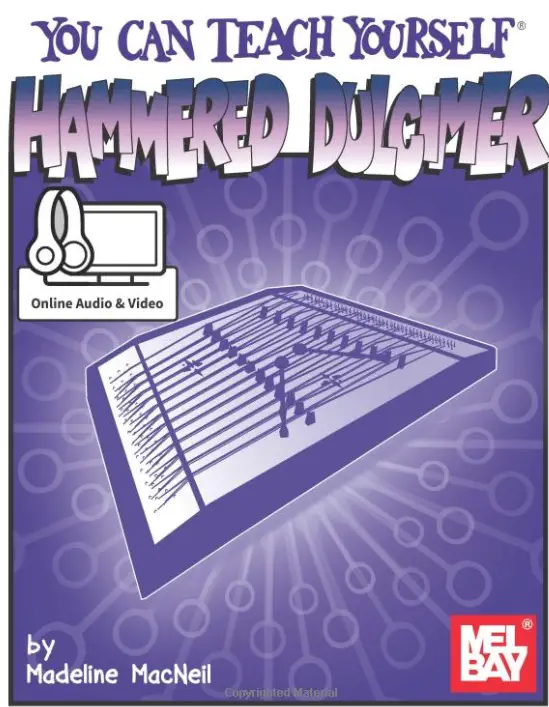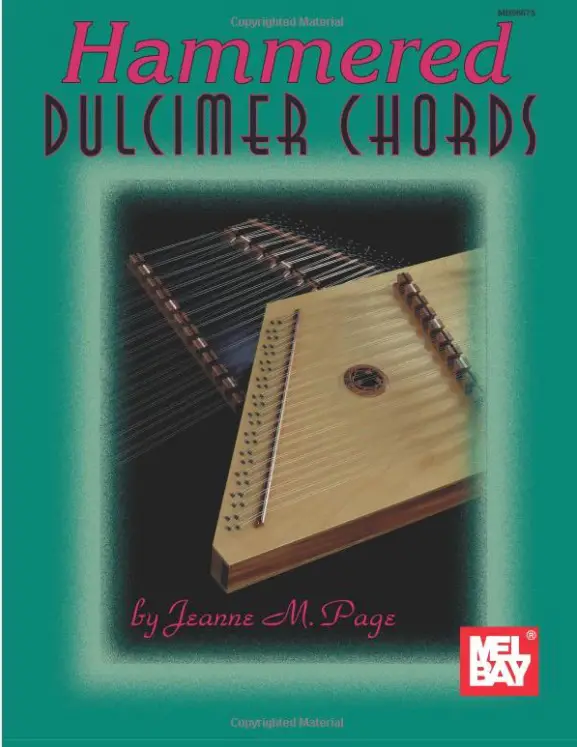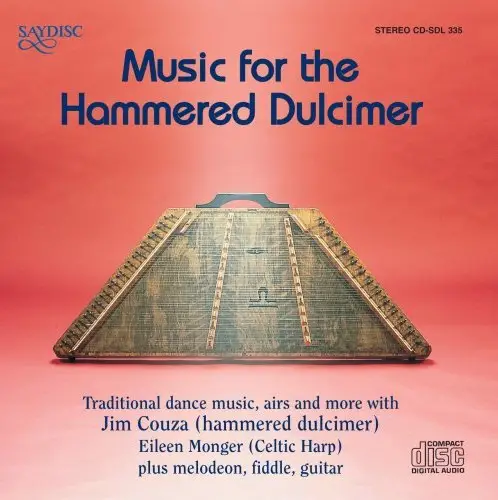Learning the Hammered Dulcimer
Folkstrings.com is reader-supported. When you buy through links on our site, we may earn a small commission.
The hammered dulcimer, sometimes referred to as the hammer dulcimer or tympanon, is a stringed percussion instrument that has been around since as early as 900 AD.
You will find these instruments in countries like Iraq, China, India, Korea, the UK, and Central Europe. Hammered dulcimers are also used in America to play folk music.
Once a person sees and hears this instrument being played with expert hands, it draws them in with intrigue. This beautiful instrument is a sight to behold.
The hammered dulcimer gets its name because of the hammers or mallets that musicians use to strike the strings and play notes.
Typically, the hammers are made of woods such as maple, cherry, or padauk, among others.
Keep reading to check out our Suggested resources for learning the hammered dulcimer.
Table of Contents
- Is a Hammered Dulcimer Hard to Play?
- Where Did the Hammered Dulcimer Originate From?
- What Is the Difference Between a Dulcimer and a Hammered Dulcimer?
- How to Learn Hammered Dulcimer? What’s the Best Way?
- Suggested Resources: Learning The Hammered Dulcimer for Beginners
- Learning the Hammered Dulcimer for Beginners – Conclusion
Is a Hammered Dulcimer Hard to Play?
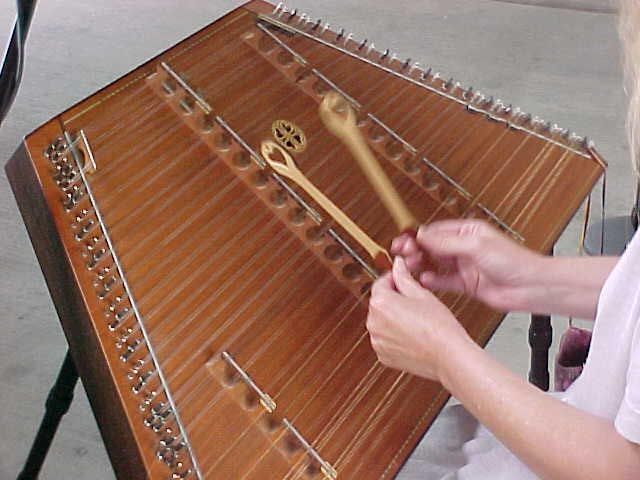
The hammered dulcimer is one of the most rewarding instruments to play. Even with very little knowledge, you can create some of the most beautiful sounds.
You can begin playing this instrument, even if you have never picked up another before. It is incredibly fun to flail away with a couple of hammers and just let yourself enjoy the music this instrument creates.
It is not overly difficult to play the hammered dulcimer, though some music pieces are harder than others.
Those who know how to play the piano will find the hammered dulcimer to be easier to play than those with no musical experience.
One of the most important things to remember when playing the hammered dulcimer is to alternate your hammer use.
Use one hand for the first note and the second hand for the next. Many musicians practice by learning to play the scales smoothly and at different speeds.
As with any instrument, the hammered dulcimer does require practice. If you are dedicated to learning this instrument, you will do well. Before long, you can begin to play beautiful melodies and begin introducing more complex music.
Where Did the Hammered Dulcimer Originate From?
The hammered dulcimer is thought to have originated from the Middle East around 900 AD. It is related to the older psaltery instrument.
Unlike the piano, hammered dulcimers were often made in homes or small shops and took on the different regional styles and personalities of folk.
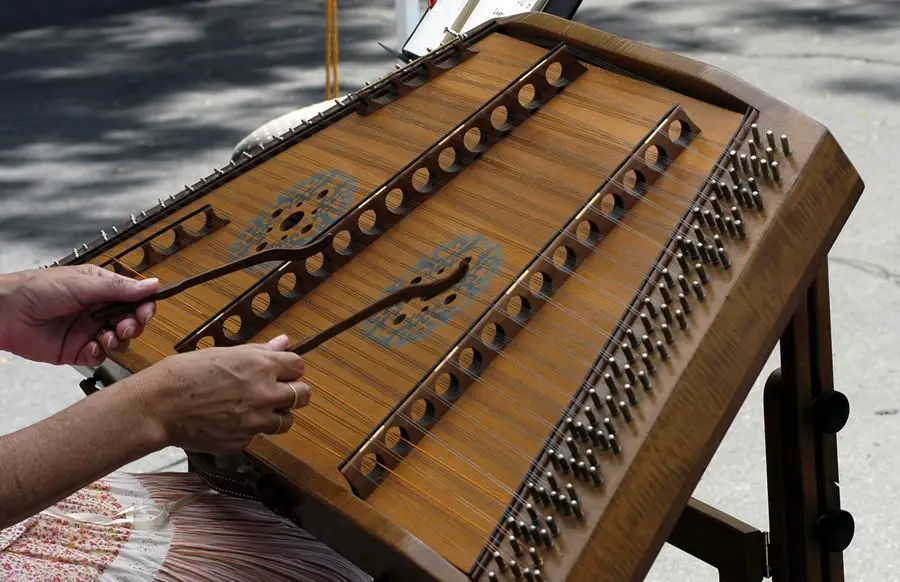
With the addition of bridges, this instrument creates two notes for each string in the ratio of a perfect fifth interval.
Some hammered dulcimers also include a bass bridge, further increasing the depth of this instrument.
In countries like America, the hammered dulcimer practically ceased production around the beginning of the 20th century. Today, it is finally making a comeback.
What Is the Difference Between a Dulcimer and a Hammered Dulcimer?
One of the primary differences between the dulcimer and the hammered dulcimer is the way they are played.
The dulcimer is often referred to as the mountain dulcimer, is plucked, whereas the hammered dulcimer is hammered.
The mountain dulcimer was traditionally played using a noter to press the strings against the frets.
The noter was held in the right hand, and the other hand was used to pluck the strings with a quill. Today’s modern musicians forego the noter and use their hands to fret the strings.
There are also differences in construction. The hammered dulcimer is larger and trapezoidal. The mountain dulcimer is crafted in a teardrop or hourglass shape.
The mountain dulcimer is considered to be more like a guitar in shape and playing style, while the hammered dulcimer is more piano-like.
Mountain dulcimers typically have three to four strings and hammered dulcimers have many courses of strings.
Technically, both of these instruments are from the same family, called board zithers.
How to Learn Hammered Dulcimer? What’s the Best Way?
Learning to play the hammered dulcimer takes practice, but this instrument is not overly difficult.
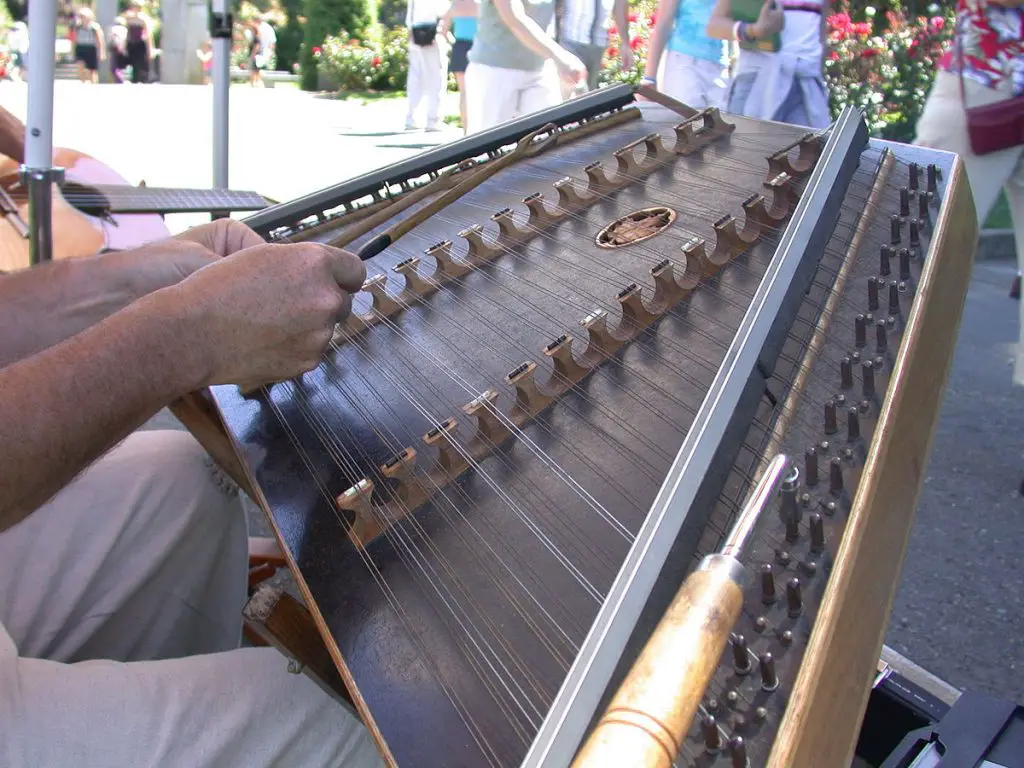
One of the first things you need to know is how to hold the hammer. You hold the hammers between your thumb and pointer finger.
This position gives you complete control over the hammer and how hard you strike.
Most hammers are made of wood, but some are covered in materials like felt or leather.
Solid wood hammers produce more of a percussion sound, whereas those covered in felt or leather will create sounds very similar to the piano.
Consider the following steps involved in playing the hammered dulcimer.
Position
Your position is incredibly important while playing the hammered dulcimer. Whether you stand or sit, you and the instrument must be in the proper position.
Most people purchase a stand for their hammered dulcimer, and it should be angled, with the longest edge facing you.
Depending on the height of your dulcimer stand, you can either sit or stand up to play. Just make sure you are comfortable.
Learn the Parts
- Bridges. There are two to three bridges, depending on whether your instrument has a bass bridge. Playing near the bridges creates notes.
- Sound holes. Your instrument may have one or more sound holes, depending on the size and construction.
- Strings. The strings are arranged in courses, which means two strings for each note. Trebles are to the right and bass to the left. If there is no bass bridge, the treble can be played on both sides.
- Hitch pins. These allow for tuning your instrument.
- Tuning pins. These are also for tuning.
On the hammered dulcimer, lower pitches are on the right, which is the opposite of the piano, which has lower pitches on the left.
Striking Notes
As mentioned before, using both hands is important when playing the hammered dulcimer.
Alternate your hammering hands. Although this may not be necessary for simple music, it will become very important when you begin to play more complex tunes.
Playing Scales
Practice playing the scales with speed and precision.
You will be slow at first, but you will improve with practice.
The best way to learn to play the hammered dulcimer is hands-on. Once you get a feel for the instrument and the sounds it creates, you can begin to use learning resources that will help you further your skills.
Some people work best with one-on-one instruction. Others find it easy to watch videos or read books on the subject. Most people find a combination of resources helps allow them to learn to play the hammered dulcimer masterfully.
Suggested Resources: Learning The Hammered Dulcimer for Beginners
Although the hammered dulcimer went on a decline in the early twentieth century, this instrument is undoubtedly making a comeback. With it becoming more popular, there are now countless resources that can help beginners learn to play. The important thing is finding expert resources that teach proper form and do so without complicating the process and causing new players to feel confused or overwhelmed.
Top 3 Suggested Books
Madeline MacNeil: You Can Teach Yourself Hammered Dulcimer.
This is a great book for beginner students, teaching the basics of the instrument and how to get started playing. It comes with a CD of Madeline MacNeil playing the instrument and instructing as she plays.
Jeanne M. Page: Hammered Dulcimer Chords.
This book is a great resource for helping you to master the most common chords played on the hammered dulcimer. This book includes diagrams for the 15/14 dulcimer.
Jim Couza: Music for the Hammered Dulcimer.
This book comes with a wide array of sheet music for all types of hammered dulcimer play. It also comes with a listening CD.
Suggested Videos
Videos offer visual instruction which is helpful for many people. You can pause the instruction and practice. If you are a visual learner, check out these resources.
This video is perfect for beginners and is one of forty that are free on YouTube. The instruction in this video is precise and easy to understand.
This is an excellent video on posture and hammer holding. It will help ensure you are prepared to play the hammered dulcimer correctly.
This video answers some FAQs regarding the hammered dulcimer. From changing the strings to tuning, many of your questions will be answered in this video.
This video is a free lesson on the hammered dulcimer. If you like, you can pay for further lessons.
Learning the Hammered Dulcimer for Beginners – Conclusion
This beautiful folk string instrument is one that needs to be played to be appreciated fully. It is fairly easy to learn to play the hammered dulcimer. Use the information and links above to help you get started on mastering this amazing old-world instrument.
Author Profile
-
Daniel Johnstone is an English writer with a love for stringed instruments from around the world.
He shares his love for these instruments through his writing for folkstrings.com, a website dedicated to all things related to folk string music.
Daniel's passion for music started at a young age, and he has since become an accomplished musician, playing guitar, cavaco, and recently, the harp.
His dedication to learning and sharing his knowledge of stringed instruments is evident in his insightful and engaging blog posts. Whether you're a seasoned musician or a beginner, Daniel's writing is sure to inspire and entertain you.
When he's not playing music or writing, you can find Daniel exploring new instruments and seeking out new sounds to share with his readers.
Latest entries
 AutoharpApril 4, 2024What Is the Autoharp Made Of: Exploring Its Materials and Craftsmanship
AutoharpApril 4, 2024What Is the Autoharp Made Of: Exploring Its Materials and Craftsmanship AutoharpApril 4, 2024Is Autoharp Easy to Play? Unveiling the Truth for Beginners
AutoharpApril 4, 2024Is Autoharp Easy to Play? Unveiling the Truth for Beginners AutoharpApril 4, 2024What Is an Autoharp Worth? Your Guide to Pricing and Value
AutoharpApril 4, 2024What Is an Autoharp Worth? Your Guide to Pricing and Value AutoharpApril 4, 2024Are Autoharp and Zither the Same Thing? Unraveling String Instrument Myths
AutoharpApril 4, 2024Are Autoharp and Zither the Same Thing? Unraveling String Instrument Myths
Affiliates:
This post may contain affiliate links that at no additional cost to you, the site may earn a small commission. We only recommend products we would use ourselves and all opinions expressed on this site are our own.
Accuracy Advice:
While we strive to provide up-to-date and accurate information, the content in this article may not reflect the most current research or medical guidelines. We encourage readers to do further research and consult with professionals for more personalized advice.
Our Recommendations:
The products and services mentioned in any of our articles are recommended based on our independent research and personal experience. We are not sponsored by any company. We aim to suggest products and services we believe are of high quality and could be beneficial to our readers.

